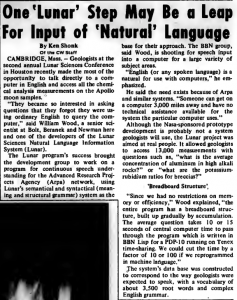April 4, 1973: Geologists use natural language system to study moon samples
Natural language processing made it possible for geologists to engage with computers and extract information about moon samples.

Natural language processing is an interdisciplinary field combining linguistics, computer science, and artificial intelligence. Modern voice assistants like Apple’s Siri and Amazon’s Alexa use natural language processing to “understand” the questions posed by users and provide intelligent responses. While early advances in natural language processing were much simpler than these modern voice assistants, they were critical in opening the doors of computing to users who were not trained in programming.
A 1973 article in Computerworld magazine describes how geologists and computer scientists collaborated to develop the Lunar Sciences Natural Language Information System (LSNLIS). The system enabled geologists to use natural language queries – questions posed in simple English, rather than programmed in code – to conveniently access, compare, and evaluate the chemical analysis data on lunar rock and soil samples taken from the Apollo moon missions. For instance, geologists could ask, “What is the average concentration of aluminum in high alkali rocks?,” according to the article. Programmed on a PDP-10 computer, the system consisted of three major components: a grammar parser, semantic interpreter, and a data retrieval component. The first two components would translate a geologist’s question from natural language into a query understood by the machine, which would then be passed to the data retrieval component to produce an answer.
In an official report on the research project, the researchers stated that they hoped the project would be a “stepping stone on the path to “make computers as generally available and conveniently accessible as one’s next-door neighbor.” The LSNLIS researchers recognized the value, both in terms of intellectual freedom and time saved, of allowing people to think in their natural language rather than require users to translate their ideas into machine language. This realization would motivate the development of the first graphic interfaces by the end of the decade, finally making computers much more usable and attractive to the average person.
–By Kathleen Esfahany